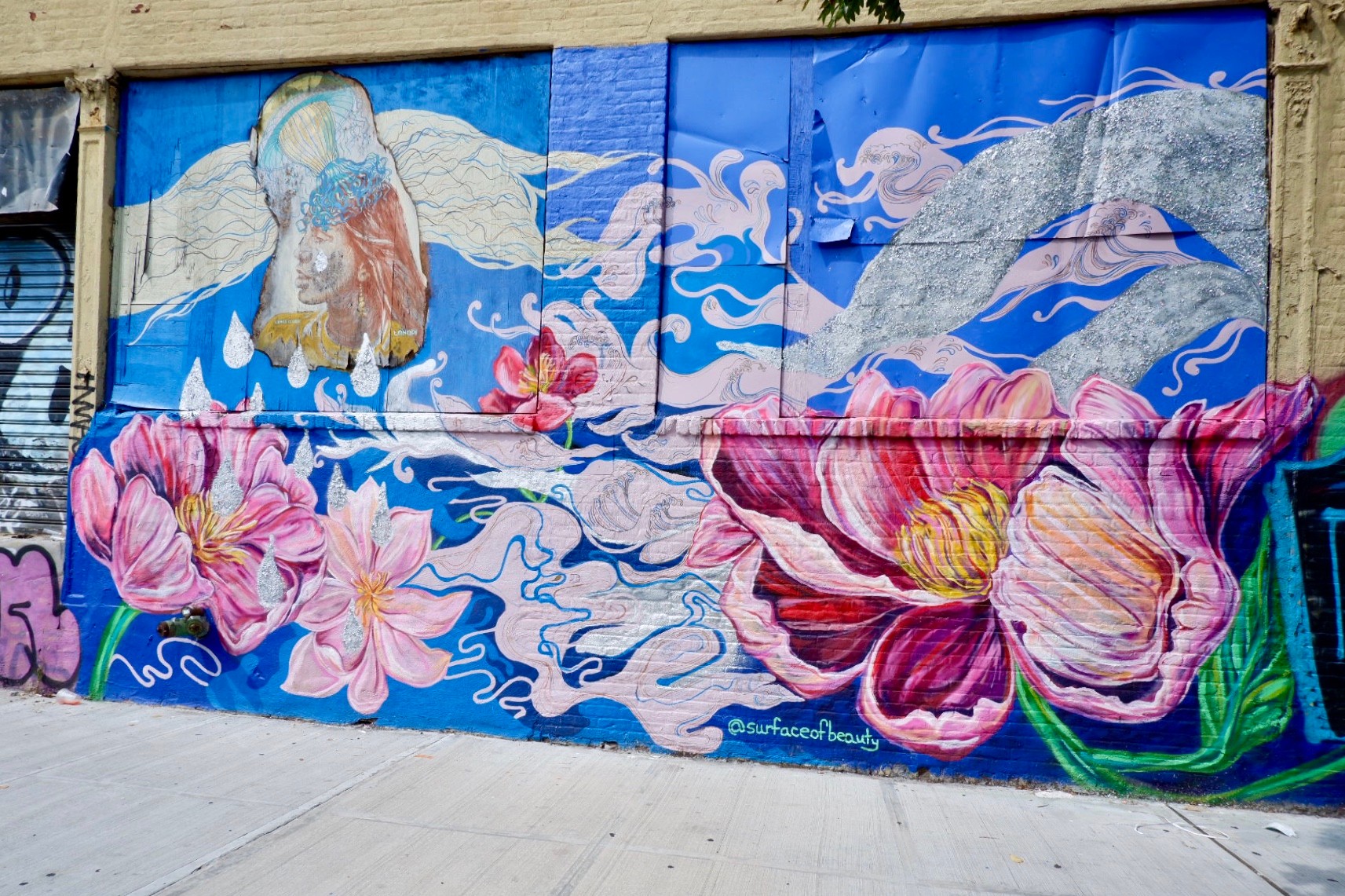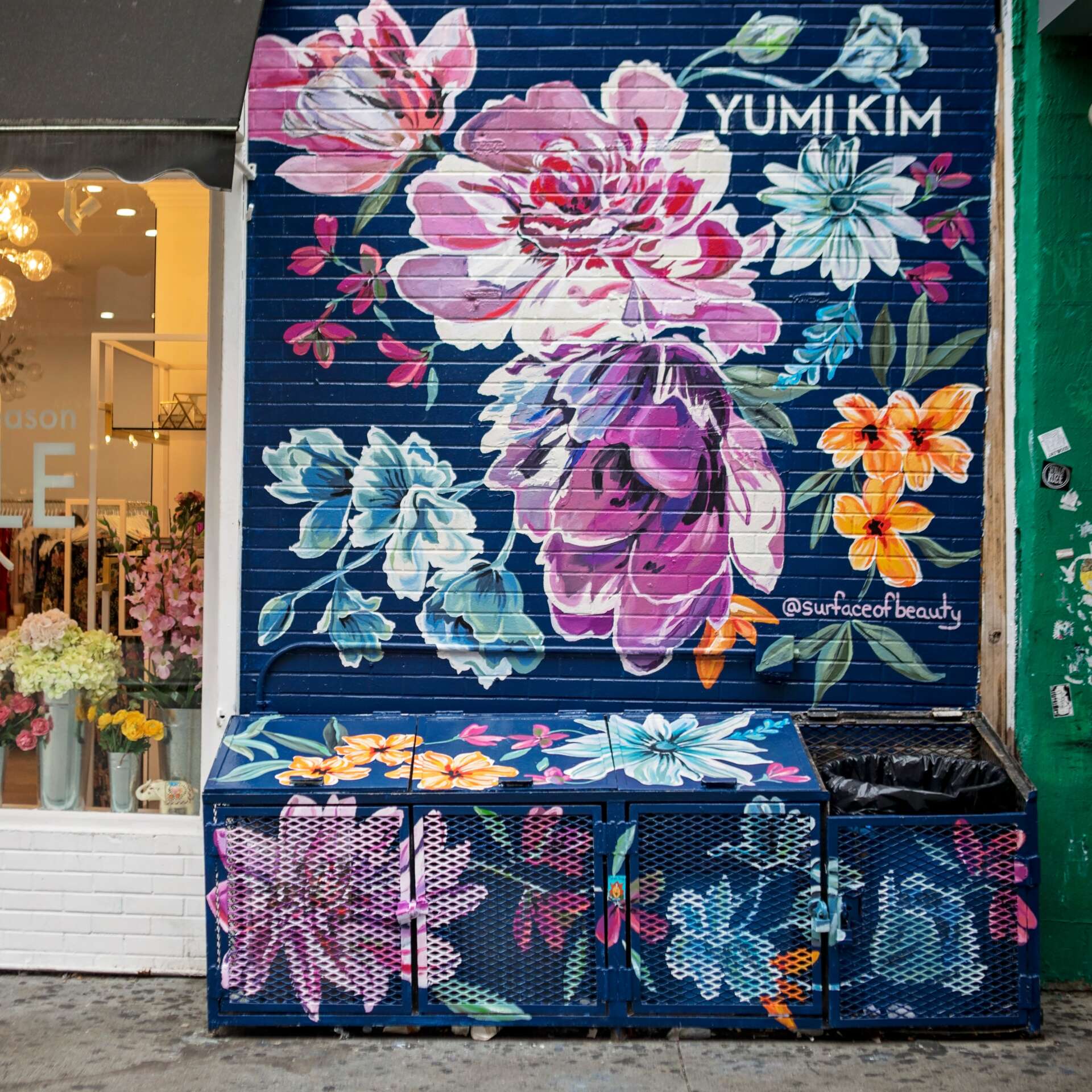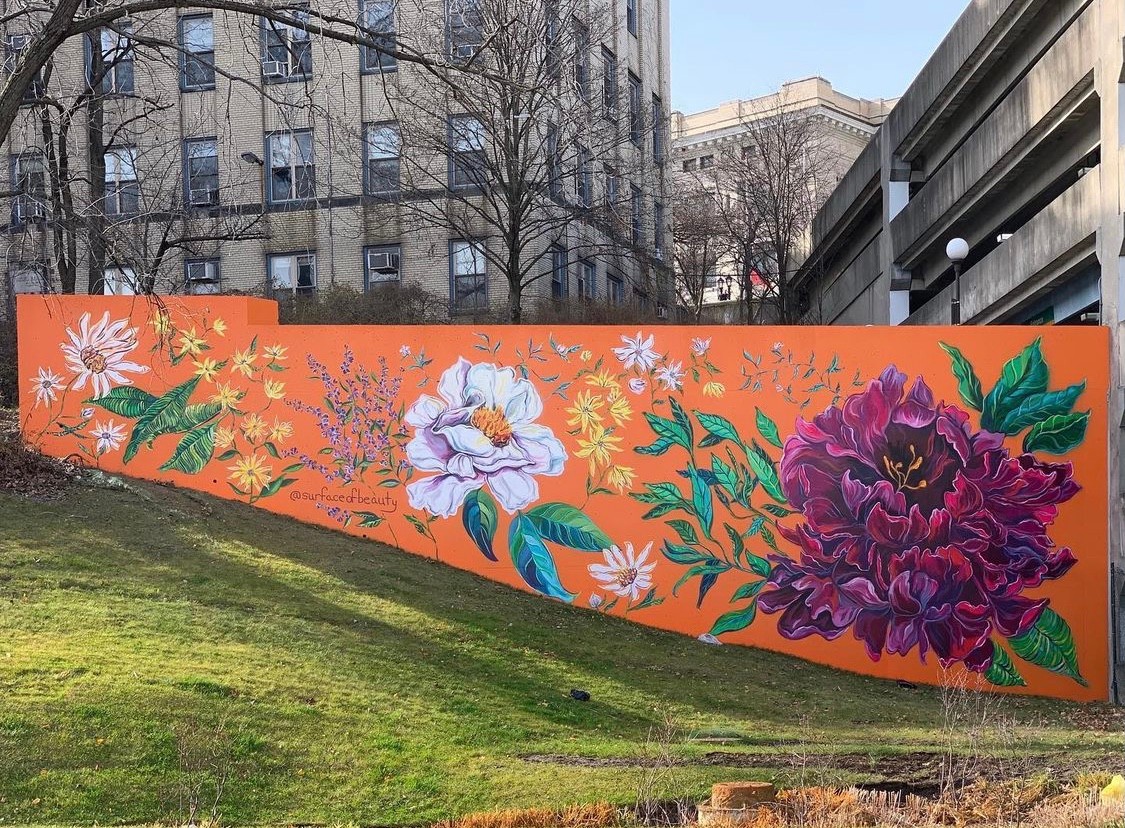We were lucky to catch up with Natasha May Platt recently and have shared our conversation below.
Natasha May, thanks for taking the time to share your stories with us today Earning a full time living from one’s creative career can be incredibly difficult. Have you been able to do so and if so, can you share some of the key parts of your journey and any important advice or lessons that might help creatives who haven’t been able to yet?
I have been earning a full-time living as an artist for the past 5 years, and in fact, I generate more income than when I was employed by a company. I started painting murals while I was still employed, so I was painting mornings, nights, and weekends for 2 years. It was a very difficult time, but also exciting. I was exhausted, because sometimes I would wake up at 4 am in order to paint before my work day began at 9 am, but it was also so encouraging and thrilling to see how I kept getting more work and how my work would build on itself to generate more engagement, possibilities, and recognition. It was a 2 year investment, but those 2 years were worth it, because by the time I was ready to leave my job and go full-time, I was already pulling in a full-time income from my art. There was almost no stress or anxiety about money when I left my job, because I had taken my time to see if I could build a sustainable business, and I went out on my own only when I was ready and had the numbers to back me up. I would highly recommend this strategy to anyone, because I feel it’s better to be physically tired while working and building a side-hustle than to be emotionally stressed from relying on an art practice that isn’t established yet to support your lifestyle. That being said, I’m still recovering physically from those 2 years of building my career, but I now have the resources to be able to chose my projects carefully and allow ample time for rest.
The turning point for me while I was building my mural side-hustle into a sustainable business was painting a small wall in the Lower East Side of Manhattan for the clothing brand Yumi Kim. I quoted low ($300) to be sure I got the opportunity, because I knew that location and the aesthetic of the brand was a perfect compliment to my own work. I always think artists should request money or exchange of services, and under no circumstance work only for “exposure,” but I also think that as an artist you should know what walls will be essential to build your career and go after those aggressively. I wouldn’t have painted a wall for $300 anywhere, but I just had a feeling that I absolutely had to paint that mural, and seeking out that project and painting it was the best decision I’ve ever made in my career. That mural became a destination and landmark of sorts for influencers, bloggers, and tourists to NY, and it was the most photographed spot in the Lower East Side for several years. There was a line on weekends of people waiting to take their photo. I ended up painting 7 different floral murals on that wall, and I still paint there to this day because that wall still continues to connect me to major projects and people who I otherwise would not meet.
Looking back, I truly do not think I could have sped up the process to becoming a full-time artist. In fact, I’m so grateful that I built a secure base and following for my work before I took the leap out on my own. It’s given me a lot of freedom at this stage in my career to turn down work and to create a holistic life for myself that includes travel, rest, and other investments. If I were still building my body of work at this point and running after projects, I feel that I would actually have lost time and quality of life in the long run.



Awesome – so before we get into the rest of our questions, can you briefly introduce yourself to our readers.
I am a mural artist painting under the name Surface of Beauty, and I paint vivid floral murals across the world. My intention and privilege as an artist is to bring nature back into urban spaces and reconnect people with the beauty and abundance of the natural world. I am known for my use of color, since I am mainly inspired by the Impressionist and Abstract Expressionist painters, and I use my large flowers as a canvas to play with an exuberant amount of color. I also portray flowers in a state of wildness and rawness, unfurling in power and mystery, as a way to deepen our appreciation of feminine energy. I am deeply influenced by the philosophical concepts of Shiva and Shakti, where Shiva is the consciousness or space, and Shakti is the movement and creative flow animating that space. In my world, Shakti is opening each and every flower I paint, as I use color and nature to animate the empty space of an industrial wall.
I started painting murals as a natural extension of the work I was doing previously, as a surface designer of some of the most expensive and intricate textiles in the world. Right after college, I moved to India and worked for three years under the top Indian fashion designer Sabyasachi. I learned everything I know about color and design from him, and had the incredible experience of working in his factory with hundreds of skilled artisans from the villages surrounding Kolkata. After I moved back to New York, I continued my work in embroidery design for US-based luxury brands, interfacing with Indian artisans in Mumbai. The intricacy and layering of the embroidery designs I was creating has directly informed my painting style, which is created through layers and layers of different colors to create texture and depth in my work.
I view my murals and my personal brand as part of the luxury world, and I consider many of my business decisions the way I was taught to think about the positioning of a luxury product in the market. For example, I was briefly represented by an agent for my mural work, and the agent pressured me to “paint faster to get more work.” I responded that I was trying to learn to paint slower, to make each piece even more unique, more special, and more high-value, and in fact, I wanted less work. That is the mindset I learned working in the luxury space, where it is not a race to the bottom, but a slow climb to the top, where the time something takes is an advantage not a disadvantage, and where the right customer pays more for the imperfections of the hand, as opposed to the sterile perfection of mass-production. These values have shaped my business thinking, and freed me to work with the most beautiful businesses in the world, who value the time my work takes and appreciate me for exactly that reason. I’m so glad I didn’t get sucked into the “hustle culture” of trying to do more, faster. Let us always do less, slower. To me, working in luxury fashion gave me the confidence to articulate this approach to creation and income generation (because let us not forget, luxury fashion brands are some of the wealthiest companies in the world, so it is a viable economic option!), and it’s inextricably a part of every work and personal decision I make.



Are there any books, videos, essays or other resources that have significantly impacted your management and entrepreneurial thinking and philosophy?
When people ask me what book they should read to become an artist, I recommend “The War of Art” by Steven Pressfield, when people ask me how to create a business, I recommend “Cashflow Quadrant” by Robert Kiyosaki, and when people ask me how to deal with emotional challenges, I recommend “Your Resonant Self” by Sarah Peyton. These three areas of life–creativity, financial freedom, and emotional integration– are for me the essential pillars of a balanced life, and these three books represent my foundational philosophy in each area. Each of these three books initiated and inspired a fundamental shift in how I was living and moving in the world, and I consider all three to be the foundation of the life I have now created for myself and currently enjoy. I will summarize the core lesson I got from each of the three books, and what change it inspired in my life. I feel that lessons I learned from each book are now core philosophies I carry with me each day and bring into every decision making process in my business and personal life.
I read the “The War of Art” at a time when I was creatively blocked, before I started my career as a mural artist, and I had a fear of the “blank canvas.” The takeaway I got from this book is that those who create more, just a sheer volume of work, create better work. The author describes an experiment he did on two college classes– one class had to work all year on one “master project,” and they would be graded on how well the final project came out. Another class just had to create as much as they possibly could every class, and they would be graded on the sheer volume of work they were able to produce. The class that focused on quantity ended up creating far better quality work than the class that focused solely on quality. I took this message and ran with it. I decided to stop judging myself on how good my work was, but only on if I put in the time every day. I diligently started painting 2 hours a day, no matter what, and didn’t even give a thought to the output I created. In less than 3 years after I implemented this practice, I was able to quit my job to become a full-time muralist, and I also credit this approach with being able to tackle huge walls as a muralist without fear.
I read “Cashflow Quadrant” around the time when I started getting work as a muralist, and I was running around NYC with my paints, so excited to be working more and earning more. The main takeaway I got from Cashflow Quadrant was that there are two types of financial success, and one results in more time, and one results in less time. The author describes witnessing the journey of two men’s success stories in his childhood: his friend’s dad become richer and had more free time, because his wealth came from investments and passive income, while his own dad also became richer and more influential but became busier and busier because his wealth came from his own time and skills. The author posits that any self-employed person who relies on their own time to generate income (including lawyers and doctors as well as artists and creatives) will have less time the more successful and well-known they become. I had some painfully honest brainstorming sessions with myself and realized that I was on the path to where my success would mean less time, and I decided to change the philosophy of my business. I bought some real estate, and I decided to take less projects and generate my income through working on fewer but higher budget murals each year, rather than as many murals as I could possibly do in a year. I constantly think now in terms of how I can simultaneously generate more income and more free time, rather than just focusing on the excitement of generating income at the cost of my own time.
Lastly, I read “Your Resonant Self” when my business was already established, and I created it in such a way that I did benefit from and enjoy long periods of free time. I thought I had good mental health because I meditate every day, and I function well in the world, and I have a good social life and enjoy many activities. This book brought my attention to something called the Default Mode Network, which is the constant running commentary or self-talk that is sort of always running in the background, the way a refrigerator might hum in the background of your living room. I had never been aware of or really heard my default thoughts, partly because I used so much energy to override them through lots of activity, socializing, and achievements, and even meditation, which can jumps over the thoughts to go to a more transcendental place. But they were humming in the background the whole time, and they were not good. This book was an invitation, albeit shocking, for me to realize that there were many aspects of my mental and emotional health that were not well. Inviting those repressed inner emotions to come to the surface, to actually listen to them instead of override them, has become my current journey. It is often painful to encounter these shadow selves, or more dense emotions, but I believe it is probably the most important work of my life– to integrate conflicting parts and become more whole. I have noticed and experienced that when our desires, thoughts, words, and actions are aligned, life becomes clearer and things move easily and joyfully with less confusion, force, or resistance.
For you, what’s the most rewarding aspect of being a creative?
My highest value is freedom and autonomy, which to me means being able to decide how I want to direct my energy and how I want to spend my time on this planet. I did work in a typical structured 9-5 job for several years, and I constantly felt that I could be making better use of my time if I had the ability to decide what hours I needed to work on any given day. If I simplify all my subsequent life decisions which led me to be an independent artist, essentially my motivation was to design a life where I can honor the rhythms of my body, my emotions, my energy, and the seasons, which I believe is a natural right and necessity of a human. It is still my greatest joy and source of pride that I can wake up each and every day of my life, feel into how I am feeling, and decide what will be the most aligned, interesting, and effortless form in which I can express my energy that day. Sometimes that looks like painting for 12 hours outside, in challenging weather conditions, and I feel the thrill that I can embody my hero energy and create beauty in adversity. Other times that looks like spending the first part of my day in bed, crying and journaling, and finally getting to release the repressed emotions of a lifetime that I never had time to feel. Other times that looks like booking a plane ticket four hours before the flight leaves and travelling across a continent simply to visit a friend or go to a fun workshop. On most days it looks like a simple balance of activities, done in my own time and in my own flow. Some exercise, some meditation, some work, some socializing, some nature, some creativity.
I am extremely grateful that I am able to live in the service of creating beauty and honoring the rhythms of nature in my work and my life.
Contact Info:
- Website: https://www.natashamayplatt.com/
- Instagram: https://www.instagram.com/surfaceofbeauty/
- Youtube: https://www.youtube.com/channel/UChjn-bugWEDItGH6ByyLznA


